The Angel in Miss Jones
POSTED ON 06/09/201016 years ago, Katie Jones left Thierrys, a UK wine importer, to take up a job in sales and marketing with the Mont Tauch co-operative in the South of France. At first, she hated the isolation and home thoughts from abroad soon flooded in. Then she started to travel, to Sweden, America and Asia, She was enjoying life again. So much so that she even got hitched to one of the Co-op's members. It didn’t last, and she decided it was time to return home - to the French-sounding but not very French Ashby de la Zouch.
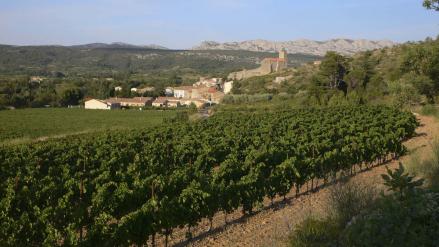 Paziols, Katie's village
Paziols, Katie's village
When I first met Katie in the mid-1990s, she was living in a small house in a narrow alley in the pretty little village of Paziols just down the road from Tuchan. Later, after the divorce, she was amazed, and thrilled, to find that the villagers, far from judgmental, were incredibly supportive, and she resolved to tough it out. She had had her eye on a beautiful house at the top of the village near the church, which dominates the skyline. When the chance came up to buy it, she took her opportunity.
Meanwhile when Mont Tauch started to work with the neighbouring Maury Co-operative just across the Languedoc border into the Roussillon, Katie was immediately struck by the fantastic potential of the Maury Valley’s old vineyards of grenache and carignan, once much used for fortified wines. She decided she wanted a plot of land with a hut on it to while away the weekend hours. She was taken to see a few vineyards, all with huts on them, by the president of the Maury Co-op, but none quite fitted the bill.
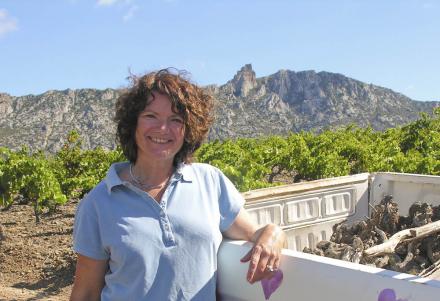 Katie's truck, Katie's vineyard
Katie's truck, Katie's vineyard
Then along came a M.Baurrel, with an eight hectare vineyard for sale. It was far bigger than she wanted but when she saw it she just knew she had to buy it, or part of it at least. At the back of her mind, she’d always wanted to make her own wine and this vineyard, the closest in Maury to the spectacular Cathar castle of Quéribus, was too good an opportunity to miss. So she found a local producer to go in with - and at the last minute before signing, he dropped out.
On the same day, he changed his mind and they divided the property between them. One side, his side, was perfectly planted with old grenache vines – and had a hut on it. The other, Katie’s side, was not so neatly planted, but it had four varieties of 70 - 80 year old vines (they go back to before records began), and although it was much more difficult to work, ‘it felt right’, says Katie. Despite the lack of a hut, her fellow grower gave her the right to sit in his hut as and when she wanted to.
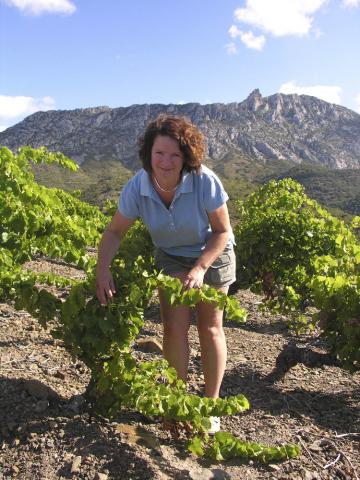 Katie - just checking
Katie - just checking
M.Baurrel had told her the vineyard was mostly planted to grenache, but what she didn’t realize until after the signing of the contract was that half of the grenache was white, grenache gris, that is. She was disappointed at first, but with its potential for good fresh acidity and minerality, it’s turned out to be a find. Grenache gris is a quality variety, and vines of that age are pretty rare, even in this neck of the woods.
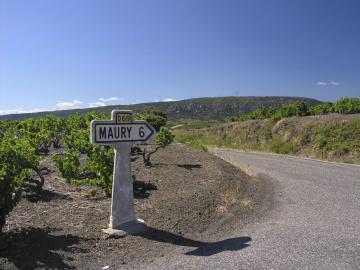 Do you know the way to Maury?
Do you know the way to Maury?
On a bright, sunny August morning, we set off for Maury with Katie behind the wheel of her ancient, battered truck. In less than half an hour, we had reached the windswept hills directly in from of the mountainous border dividing the Maury valley from the Languedoc, and the closest vineyard to Quéribus, perching precipitously on the mountain ledge. Beneath it is Katie’s vineyard, dotted with the occasional fig and wild cherry tree, and sitting in such astonishing, epic countryside you’d have to be emotionally stunted not to fall for its beauty. It’s wild boar country, and with her father’s help, Katie had erected a wild boar electric fence, which was doing the trick.
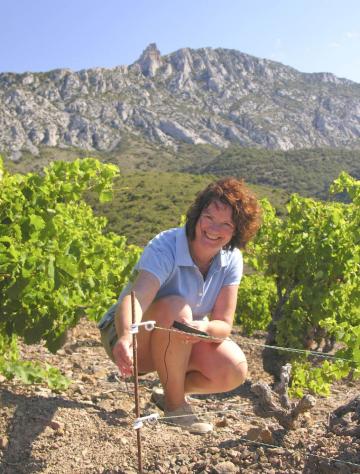 Wild boar not welcome
Wild boar not welcome
Crunchy under foot, the shattered ‘black’ schist, in fact various shades of red, brown, grey and black, makes it quite slippery on the steeper parts of the vineyard. The schist heats the grapes during the warm summer days, imparting a lot of sugar (and potential alcohol) to the grenache. Planted in bush vine form on American rootstock, the vine is flexible here, adapting well to the wind by allowing its branches to sway with the winds that blow through the valley. Whites ripen on average three weeks earlier than the reds.
Not surprisingly, yields are low, and with 8000 vines covering Katie’s 2.7 hectares, she reckons on producing a bottle per vine on average. While the vineyard in Maury cost €12,000 a hectare, her other vineyard of less than a hectare closer to Paziols in the Fitou appellation cost considerably less at €5,500 a hectare. On average, Katie reckons it costs her €5 – 6 to produce a bottle of wine.
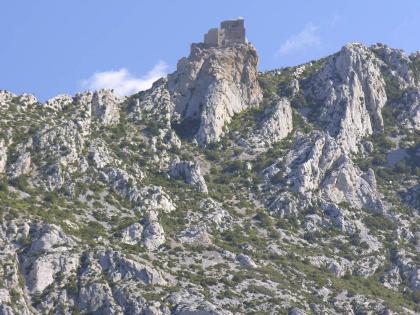 Quéribus
Quéribus
It’s been a, er, steep learning curve for Katie, who took advice on viticulture from a number of local growers, in particular her vigneron partner and adviser, Jean-Marc Astruc. Her winemaking has been influenced by the help she received from Australia’s David Morrison, a consultant winemaker, but she’s very much in charge of the operation. She has her own small winery, a 250-year-old stone garage in the Rue du Vatican (hence its nickname: The Vatican) in Tuchan, named apparently after one of the characters of the village, himself nicknamed ‘Le Pape’.
In the Astruc family since 1850, The Vatican has been adapted for winemaking with new concrete floors and electrical and drainage systems. Here there are a handful of 5 – 30 hectolitre stainless steel tanks and a few barrels. In Katie’s own words, ‘it’s a toy winery’. We try the 2009 carignan from barrel. So delicious you can see why she plans to keep it apart and bottle it separately.
I’ve known Katie since I first visited the Mont Tauch Co-op about 15 years ago and I’ve been back many times as this beautiful, tranquil Mediterranean arrière-pays is one of my favourite spots in France. You can see why she stuck it out but you also have to admire her tenacity and resilience. These are qualities, which, with her attachment to the local area and its people, and theirs to her, will stand her in good stead as she adapts to the new life she’s been working towards all these years. Yes, Katie Jones, vigneronne, is up and running.
For more information, on the area, the wines and local recipes, check out www.domainejones.com.
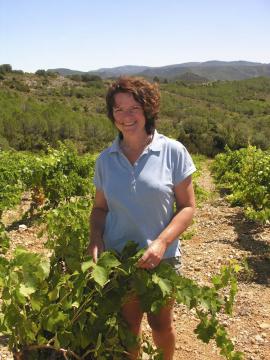 Back in Fitou - Katie's vineyard
Back in Fitou - Katie's vineyard
The 2009 Domaine Jones Blanc, made from hand picked grenache gris grapes with a touch of aromatic muscat, is a full-bodied, richly textured dry white with ripe, stonefruit flavours, a stony, mineral core balanced by fine, refreshing acidity. You wouldn't know it had spent some time in oak, but it did spend about six months in three older oak casks to help round it out.
The 2009 Jones Muscat, in half-litre bottle, is made with pure muscat a petit grains to create a wonderfull fragrant, medium sweet white whose exotically grapey flavours are juicy and fresh; like drinking a sweet liquid bunch of fresh muscat grapes.
The 2009 Jones Rouge is a full-bodied, grenache-based red, whose mulberry and red fruits flavours are delightfully pure and fresh thanks to mimimal use of oak, savoury, damsony acidity, silky textured tannins and a lightness of touch that makes this red moreishly drinkable and so different from the overtly oaky, sweet and New World styles so prevalent in this area.
The Wines are available from Stevens Garnier, Oxford (01865 263303). The red is due in later this month.
P.S.
Grenache is apparently flavour of the month, literally. It’s International Grenache Day on Friday 24 September. For anyone interested in the variety, here’s a handy guide, called the The Great Grenache Primer devised by the 2010 International Grenache Symposium in Crestet, France.
http://www.grenachesymposium.com/GrenacheNews/wp-content/uploads/2010/08...
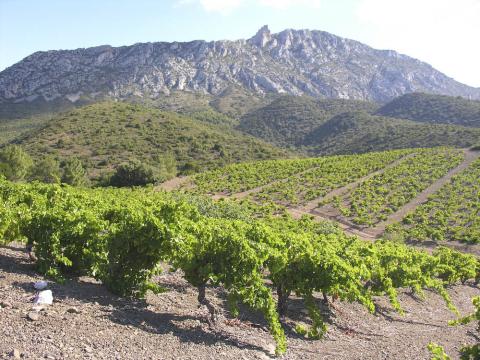 The Old Vine Grenache
The Old Vine Grenache
Next up: The Domaine of the Bee

